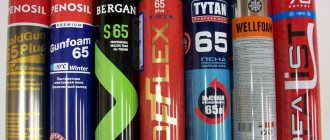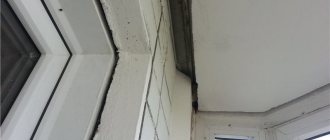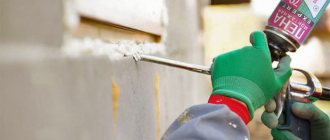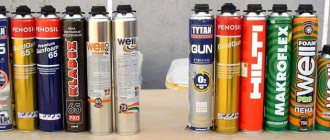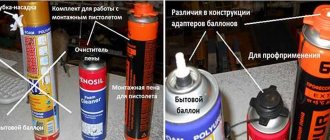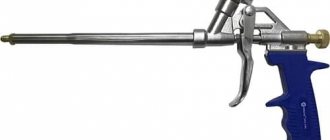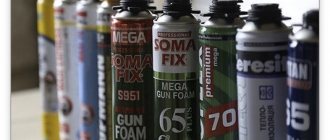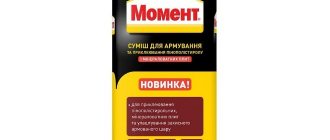Gun foam Mastertex B1 fireproof 750 ml. Photo by Leroy Merlin
One of the important advantages of polyurethane foam is its ease of use . However, there are some nuances and operating rules that ensure the quality, accuracy, reliability and durability of installation seams.
And if professionals have all the intricacies of working with foam, then novice performers and amateurs will find the information presented in the article useful.
Scope of application of construction foam
Foam Soudal Construction and Repair 500 ml. Photo Petrovich
Polyurethane foams, produced in aerosol cans of various volumes, are used to perform a wide range of works:
- when installing window and door structures;
- during installation of pipelines and electrical equipment;
- for filling cracks, gaps and voids for the purpose of thermal insulation and sealing;
- for foaming seams;
- for fastening wall panels and polymer boards;
- for treating the external surfaces of steel and cast iron baths to reduce heat transfer;
- in a significant number of repair work, foam remains an almost irreplaceable material;
- when performing finishing work;
- for creating decorative products for interior and landscape design;
- for waterproofing.
Types and forms of release
The entire range of polyurethane foams can be classified into separate groups in accordance with several criteria:
GROVER B1 professional fireproof all-season foam 750 ml. Photo by Maxidom
Depending on the method of supplying the polyurethane composition, a distinction is made between household and professional foam . Materials of the first type are sold in small volume cylinders (no more than 750 ml) equipped with a plastic tube . Great for fixing minor problems at home. Products of the second type are produced in cylinders designed to install a special gun , which allows you to monitor the foam output and its consumption. The compositions have greater density. The main feature and advantage is the possibility of repeated use.
Depending on the ambient temperature at which work is carried out, a distinction is made between summer, winter and all-season (universal) foam . For different manufacturers, the temperature ranges for each type differ slightly, on average the values are +5 to +30, from -18 to +30 and from -10 to +30 degrees, respectively.
Polyurethane foam differs according to the flammability class : marking “B1” - fire-resistant (they are also called fire-resistant and fire-resistant), “B2” - self-extinguishing substances, “B3” - flammable compounds.
Depending on the composition, one-component and two-component ones are distinguished. The second type of foam hardens faster, but it is difficult to use, so the compositions are used only by experienced professionals. Depending on the specifics of the work performed, it is possible to choose foam with a large or small expansion coefficient.
How to apply, mistakes when performing work
Failure to follow the previously presented recommendations is the main mistakes that can lead to problems during work and/or after its completion. In addition, it is possible to note other errors:
Incorrect position of the cylinder when installing the gun. The cylinder must be kept upside down. The optimal solution is to place the container on a flat, hard surface and screw the gun on top.
Using a cold balloon. Often work is carried out in unheated rooms or outdoors, as a result the container is cooled, which reduces the yield of foam and its expansion. Therefore, the balloon must be heated to a temperature of at least +10 degrees; this must be done in warm water or in a room. Do not heat containers on a gas stove or other open flame sources. This may cause the cylinder to explode.
Improper storage of the cylinder. During breaks in work, there is no need to remove the gun from the cylinder. The container is stored in an upright position, the valve must be cleaned with acetone and closed.
How to use correctly: do you need to wet the surface before applying foam, why and others
To eliminate the possibility of any problems arising when performing minor and major repairs of an apartment, house, bathhouse and other premises, you must be able to use both household and professional foam. We will talk about the differences in the operation of the compositions further. And now it is necessary to present general recommendations and answer popular questions that arise among do-it-yourself workers.
Pistol foam Maxi Arctic, professional, 870 ml. Photo by Leroy Merlin
1) Do I need to wet the surface before applying foam? The curing process occurs at a humidity of at least 40-50%. Insufficient moisture content in the air causes the composition to gain volume less easily. Construction work is carried out in various conditions, in most cases non-ideal. Therefore, before applying the foam, it is recommended to moisten the work surface with plain water; for this you can use a spray bottle or a regular plastic bottle.
Reference. When performing work at subzero temperatures, it is not recommended to wet the surface with water, as this can lead to icing. In these cases, it is necessary to use special frost-resistant compounds.
2) Why wet the surface? Polyurethane foam adheres better to a damp (!but not overly wet) surface than to a dry one. Therefore, when performing work in hard-to-reach places, it is especially recommended to follow this advice. To reduce the curing time, it is recommended to moisten the finished seam with water, this is especially true when applying several layers.
3) Why shake the can before performing work? The foam contains a prepolymer, i.e. a mixture of substances and a gaseous propellant. The components have different densities, so they are distributed unevenly in the cylinder. To mix the components, prepare the foam and bring it into working condition, you must thoroughly shake the container for 30 seconds. Some manufacturers offer their own recommendations. For example, Makroflex suggests shaking the container 15-20 times.
Important! It is necessary to shake the cylinder only with the protective cap or with the gun installed. Shaking the container while it is open will cause the foam to come out prematurely.
4) Why turn the cylinder over during work? Despite the logical location of the container with the nozzle up, the cylinder must be turned upside down. The propellant gas contained in the composition will rise and put pressure on the foam, which provides the maximum (specified by the manufacturer) yield. However, it is possible to find materials on sale that are suitable for performing work in any position, for example, Tytan Lexy.
5) What is the optimal temperature for use? The best results can be obtained at ambient and cylinder temperatures from +20 to +25 degrees Celsius. To bring the container to the desired temperature, it must be placed in a warm room or in water. It is PROHIBITED to heat the container, this may lead to the container exploding.
Polyurethane foam TYTAN LEXY 20 300 ml. Photo by Maxidom
6) Is it possible to work with foam without gloves? Polyurethane foam is a chemically active polymer, and therefore can leave burns on the skin or cause allergies if inhaled. In addition, to remove fresh and especially hardened foam, you will need a cleaner, acetone or other means. Therefore, before performing work, it is necessary to wear gloves, a mask or goggles with a respirator, and clothing with long sleeves.
7) Does the foam exert pressure on structures as it expands and cures? Yes. Therefore, cracks and other spaces must be filled to one third.
Reference. Secondary expansion depends on many factors, in particular the specific manufacturer and the chemical formula of the composition. Therefore, it is recommended to use products of the same brand in order to understand how the composition will behave.
Is it possible to foam seams larger than 100 mm? Seam sealing up to 50 mm. carried out in one layer. For foaming gaps of 50-100 mm. two layers are needed. For sealing joints over 100 mm. you need to use additional elements: wooden blocks or bricks.
9) Why do installation seams require additional processing? Polyurethane foam is sensitive to ultraviolet radiation. Exposed seams will darken and deteriorate over time.
Mounting foam MACROFLEX WhiteTeq professional 750 ml. Photo by Maxidom
10) Does polyurethane foam have an expiration date? Yes, products have a limited shelf life, the average is 12 months. Using expired materials is not dangerous, but the required result will not be obtained. Storage in warm and/or humid conditions shortens the shelf life; in cold conditions, it leads to a slow release of the composition from the container.
Reference. Polyurethane foams should be stored in cool and dry conditions, in an upright position, with the flap facing up. A horizontal position will cause the valves to malfunction.
Recommendations for using cylinders with a gun
Professional foam is in most cases used by specialists in the construction industry. However, it can also be used to solve problems at home. Using a gun provides several advantages, in particular, it allows you to keep the composition in a liquid state and dose the output of the material. Therefore, performers are interested in several questions.
Professional mounting foam TECHNONICOL 65 MAXIMUM for gun. Photo Petrovich
1) The gun is installed as follows.
* The protective cover at the top of the gun is removed. The gun is turned with the handle down and the cylinder is screwed into it. The container is screwed in with force until a hissing sound appears, which means the mixture enters the instrument.
Reference. If the gun has already been used, it must be rinsed first. If no hissing appears, then the gun is dirty and you need to purchase a new one.
Attention! Often, when installing a gun, the performer turns the cylinder upside down, which can lead to involuntary release of foam. Therefore, in order to screw the gun on, you need to place the cylinder on a hard surface.
* Before performing work, the cylinder with the gun must be shaken several times, turn the adjusting screw a quarter turn and, holding the trigger, begin application.
Reference. Some manufacturers offer extending flexible adapters complete with professional foams for the convenience of working in hard-to-reach places, on the ceiling, as well as for filling deep cracks.
2) Applying foam using a gun is carried out as follows:
* surface and cylinder preparation;
* the gun nozzle is directed to the work surface;
* foam is supplied by smoothly pressing the trigger;
Reference. The gun has a special disk/screw, the rotation of which allows you to adjust the pressure and foam output.
* vertical seams are filled from bottom to top;
Important! When filling joints, the tip of the gun must be immersed in the foam.
* wide gaps (70-80 mm) are filled with zigzag movements;
Advice. After 30 minutes, the treated surface is checked for defects. It is better to supplement the area with foam afterwards than to remove excess. It is possible to cut off excess weight only after at least 8 hours, optimally 12.
* in the process of applying foam, the gun may “shoot” air, in such cases the container must be shaken;
* if the foam runs out, you need to replace the cylinder with a new one. To do this, you need to release the remaining foam and gas, unscrew the empty container from the gun, remove the composition from the adapter using a cleaner and screw on a new container;
Reference. Some versions of the guns have a Teflon-coated tip; foam does not stick to it.
* storing an unfinished cylinder with a gun is possible for two weeks, for this it is necessary to block the trigger, then air will not penetrate into the cylinder and the composition will not harden.
How to use a regular can with a straw, is it possible several times and more?
Household foam cylinders are supplemented only with a tube made of polymer material ; no special tools are required. The work is carried out in a similar sequence, but more effort will be required. Therefore, the use of household compounds is relevant for carrying out work of small quantities and of low complexity. In particular, for filling cracks and gaps, filling joints, gluing delicate materials. The workflow using products in conventional cylinders has some disadvantages:
- Significant foam consumption. The foam output is controlled by the force and duration of pressing the valve. As a result, professional foam is consumed 1.5-2 times slower.
- Difficult to use. Polymer tubes are flexible, making them more difficult to hold in position.
Household mounting foam Makroflex 500 ml. SHAKETEC. Photo by Maxidom
To make using tube cylinders easier, you need to know a few rules:
1) The absence of a gun makes it difficult to regulate the foam output. To prevent errors in work, it is necessary to check the feed intensity on the rough material.
2) Household compositions have a significantly higher expansion coefficient .
3) Working without a gun increases the likelihood of accidental contact with other surfaces and clothing. Therefore, you need to stock up on a sponge and acetone or a special product.
4) Manufacturers note that household foam cylinders are disposable . However, there is the possibility of reuse . The performers offer several options for action. Let's consider one of them. To do this, you need to release a small amount of foam from the container, and allowing it to come out, bend the tube and tighten it with metal wire. Thus, it is recommended to store the container for a maximum of 2-3 weeks. When using the cylinder subsequently, it is necessary to cut off part of the tube with the frozen composition and continue foaming.
Without straw
Foam canisters without a tube are not used. Such experiments may result in injury. Therefore, you need to purchase a tube separately or buy a balloon with a tube.
Door leaf installation
Work is carried out after the frame is securely fastened in the passage
However, before hanging the product, it is important to increase the reliability of the structure. To do this, the remaining gaps between the frame and the wall are blown in using foam.
In this case, it is necessary to place special spacers in the box, which will avoid damage and distortion of the structure when the foam expands.
The sash is hung from the open door position. To do this, the product is lifted above the counter pin in the frame and placed on it. If necessary, the position of the door relative to the floor and walls is adjusted by tightening the fastening elements of the hinges. After this, the product is checked several times for correct placement by opening and closing.
The final stage of installation of a new interior door is the installation of platbands. After marking the decorative strip, it is cut using a circular saw or a fine-toothed hacksaw. The upper sections are cut at an acute angle of 45 degrees. After the fitting procedure, the planks are installed. To fasten them, use construction adhesive or finishing nails. It is also permissible to use self-tapping screws and then disguise them with decorative plugs to match the trim. After reading our instructions, you will now easily understand how to easily change interior doors yourself and avoid mistakes.
Popular questions, is it possible...
Of increased interest is not only the rules and recommendations for the use of polyurethane foam, but also individual works. Internet users are interested in whether it is possible to use polyurethane compounds for the tasks presented below.
Professional mounting foam TYTAN 65 750ml. Stroylandia Photos
...foam the wiring
No. Electrical wiring regulations prohibit the use of foam. The grooves must be sealed with gypsum or cement-sand mortars.
...foam the socket
Can. There are no restrictions that would prohibit the installation of socket boxes on foam. The main thing is that the foam does not get on the contacts. It is also possible to foam the gaps in the places where the sockets are attached. To do this, you need to turn off the electricity, dismantle the socket, insulate the live wires, foam carefully and carefully, it is recommended to cover the foam with plaster, return the socket to its place, when the plaster has dried, turn on the electricity.
...foam the heating pipes
Not recommended. SNiP 41-01-2003. Heating, ventilation and air conditioning provided the following information on this issue: “Pipelines at the intersections of ceilings, internal walls and partitions should be laid in sleeves made of non-combustible materials; the edges of the sleeves must be flush with the surfaces of walls, partitions and ceilings. The sealing of gaps and holes in places where pipelines are laid should be provided with non-combustible materials, ensuring the rated fire resistance limit of the fences.”
Professional fireproof mounting foam KRAFTOOL Kraftflex Premium B1 750 ml. Stroylandia Photos
Those. the use of foam is undesirable. However, if it is still used, then it is necessary to choose options that are resistant to high temperatures.
...foam the bathhouse from the inside
Not recommended. Using polyurethane foam in a bathhouse is possible, but it is recommended to choose fire-resistant options, this is especially true for a steam room. However, you need to understand that foam is a synthetic material, the use of which in a room with natural, environmentally friendly logs or timber, boards and stone is not desirable, but possible. And the optimal solution is high-temperature sealants.
...foam the log house
Not recommended. Polyurethane foam can be used to foam joints in a log house only as a temporary measure. Since the use of polyurethane compounds:
- leads to a violation of the environmental friendliness of a wooden structure;
- moisture may accumulate at the junctions of foam and wood, which will lead to rotting;
- wood, unlike foam, is a breathable material;
- insufficient elasticity of the foam will lead to the formation of cracks;
- compositions with a large coefficient can lead to increased joints and gaps.
... insulate the walls
Can. Polyurethane foam has the necessary characteristics to solve this problem, but is not insulation. In addition, a wide selection of thermal insulation materials is available for sale. As a result, the consumer has the opportunity to choose an option with optimal properties.
...foam the sills in the car
It is possible, but the hygroscopicity of the foam (a significant part of the foam options absorbs and retains moisture) will lead to rotting of the thresholds.
Should there be a pistol or not?
If you can work with household foam with a tube, then why buy a professional cylinder that requires a gun? An unreasonable waste of money, and that's all. That's how it is. However, experts (including myself) still recommend using “weapons”. Why? Well, maybe because it is known for the following benefits:
- minimum consumption - the gun releases foam in doses, and the tube leads to excess consumption of the substance by 2-3 times;
- accuracy - the gun nozzle is very narrow, and is also adjustable, which allows you to fill even the tiniest cracks;
- speed - 10-30 seconds are enough to make a 2-meter seam, and you will have to work with the tube for about 15 minutes (of course, all this is figurative and depends on the specific working conditions).
An anecdote on the topic: - How did your husband let you go to a nightclub? - Yes, I prepared a bath for him and filled it with foam! - And that stopped him? — Polyurethane foam will stop anyone.
Polyurethane foam sealant is a universal tool that allows you to easily deal with any cracks, gaps, cracks and voids, even in the absence of a gun. Although not as high quality, but still...
Wishing you fast and high-quality work, dear fellow builders! See you!
Wisdom Quote: Knowledge is always preceded by a sentence (Alexander Humboldt).
How long does it take to dry?
Polyurethane foam has numerous positive properties: excellent adhesion, low shrinkage, ease of use, low thermal conductivity, and others. Individual properties are important when choosing products, as they determine the areas of application. And some parameters will be useful to the contractor already during the work. One of these parameters is the duration of drying and curing, knowledge of which allows you to have information about when it is possible to continue working with assembly joints.
Recommendations for using low expansion foam
Polyurethane foam with a low coefficient of expansion is used for cracks up to ten centimeters. The expansion coefficient indicates how much the distributed volume of mass will change from the original.
Basic recommendations for use:
- If the gap is one centimeter wide, then sealants without secondary expansion must be used.
- If you need to fill cracks of more than 10 cm with such a composition, then it is advisable to use compactors to reduce the space and reduce the likelihood of the mass draining under its own weight.
- For better adhesion, the planes are moistened, and after distributing the mixture and initial drying, the seam is treated with water from a sprayer.
- Poor adhesion to silicone, polyethylene, Teflon, and uncleaned surfaces.
